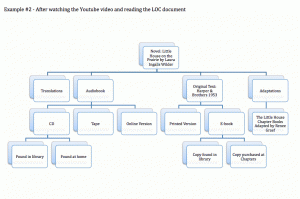FRBR Model of Little House on the Prairie
I began making my FRBR model with the work Little House on the Prairie by Laura Ingalls Wilder. From there I broke the work down into three different expressions; printed book, musical and television show. This is where I started getting confused. Was a translation or the audiobook version of the printed text a new expression or a manifestation of the original text? Was the mini-series television show an expression of the television show or was it a manifestation? I found a Youtube video describing the FRBR model of Dracula as well as a document on the Library of Congress website that helped to guide my decisions. I found the FRBR model in the course module to be simplistic and did not match how the Library of Congress describes the FRBR model. Little House on the Prairie, like Romeo and Juliet, has a screenplay as well as a movie and adaptations of the text. In the Romeo and Juliet example the screenplay and movie are listed in under the same work. However, according to the LOC document and the Youtube video, a movie or TV show is considered a new work. These works (the novel, the movie and the TV shows) could be considered to be part of a “family of works” (Tiellet, 2003, pg. 13). For this reason, I have changed my FRBR model to represent three different works; one for the novel, one for the musical and one for the TV shows. When changing my model, I wondered if the TV show model could be further broken down into different works. I decided to leave it the way it was and focus my attention on the FRBR model for the novel.
As I was building my FRBR models, I had several thoughts going through my mind including that this process was far too complicated and that no teacher-librarian would ever have time to do this. I prefer Rob Styles’ method of looking at the FRBR model. He questions the use of the terms work, expression and manifestation (Styles, 2009). He also compares two FRBR models; one in which the movie is an expression of the novel and one in which the movie is considered a new work. He points out that when the movie is an expression it implies that the “movie is somehow a lesser creative work than the original novel” but when it is its own work the model has failed to show the relationship between the movie and novel (Styles, 2009). This shows the complexity of the FRBR model.
I think the use of the FRBR levels makes sense when searching through the collection. It allows the user to identify which expression they are looking at, i.e. is it a translation? It also allows users to identify what format the work is in and if the library has the item. It is interesting to note that the LOC document said “less than 20% of all the records in the OCLC database have more than a single manifestation” (Tillet, 2003, 14). From what I understand a print version and ebook are different manifestations of the same expression. Will the number of records rise as more ebooks and online versions of material rise? How will this change the way that the FRBR is used in cataloguing? If libraries begin to catalog websites how will the FRBR model work?

This was the FRBR model I came up with before reading the LOC article and watching the Youtube video.

This was the model I came up with after reading the LOC article and watching the Youtube movie. Note: I have separated the works.
Works Cited
Bram Stoker’s Dracula in FRBR terms [Video file]. (n.d.). Retrieved from https://www.youtube.com/watch?v=LN0vKCFsXPE
Styles, R. (2009, November 11). Bringing FRBR Down to Earth… | I _Really_ Don’t Know [Web log post]. Retrieved from http://dynamicorange.com/2009/11/11/bringing-frbr-down-to-earth/
Tillet, B. B. (April 2003). The FBRR Model [Abstract] (Conference). Retrieved from Library of Congress website: http://www.loc.gov/catdir/cpso/frbreng.pdf

Emily, you present a good point about how to define a work. I was wondering the same thing and I can see your point about the value of treating each as a separate work. Thanks for supplying the extra resources that you used for examples.